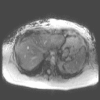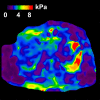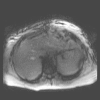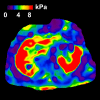Diagnostic Performance of MR Elastography and Vibration-controlled Transient Elastography in the Detection of Hepatic Fibrosis in Patients with Severe to Morbid Obesity
- PMID: 27861111
- PMCID: PMC5395333
- DOI: 10.1148/radiol.2016160685
Diagnostic Performance of MR Elastography and Vibration-controlled Transient Elastography in the Detection of Hepatic Fibrosis in Patients with Severe to Morbid Obesity
Abstract
Purpose To evaluate the diagnostic performance and examination success rate of magnetic resonance (MR) elastography and vibration-controlled transient elastography (VCTE) in the detection of hepatic fibrosis in patients with severe to morbid obesity. Materials and Methods This prospective and HIPAA-compliant study was approved by the institutional review board. A total of 111 patients (71 women, 40 men) participated. Written informed consent was obtained from all patients. Patients underwent MR elastography with two readers and VCTE with three observers to acquire liver stiffness measurements for liver fibrosis assessment. The results were compared with those from liver biopsy. Each pathology specimen was evaluated by two hepatopathologists according to the METAVIR scoring system or Brunt classification when appropriate. All imaging observers were blinded to the biopsy results, and all hepatopathologists were blinded to the imaging results. Examination success rate, interobserver agreement, and diagnostic accuracy for fibrosis detection were assessed. Results In this obese patient population (mean body mass index = 40.3 kg/m2; 95% confidence interval [CI]: 38.7 kg/m2, 41.8 kg/m2]), the examination success rate was 95.8% (92 of 96 patients) for MR elastography and 81.3% (78 of 96 patients) or 88.5% (85 of 96 patients) for VCTE. Interobserver agreement was higher with MR elastography than with biopsy (intraclass correlation coefficient, 0.95 vs 0.89). In patients with successful MR elastography and VCTE examinations (excluding unreliable VCTE examinations), both MR elastography and VCTE had excellent diagnostic accuracy in the detection of clinically significant hepatic fibrosis (stage F2-F4) (mean area under the curve: 0.93 [95% CI: 0.85, 0.97] vs 0.91 [95% CI: 0.83, 0.96]; P = .551). Conclusion In this obese patient population, both MR elastography and VCTE had excellent diagnostic performance for assessing hepatic fibrosis; MR elastography was more technically reliable than VCTE and had a higher interobserver agreement than liver biopsy. © RSNA, 2016 Online supplemental material is available for this article. An earlier incorrect version of this article appeared online. This article was corrected on January 25, 2017.
Figures







Similar articles
-
Accuracy of fibroscan, compared with histology, in analysis of liver fibrosis in patients with hepatitis B or C: a United States multicenter study.Clin Gastroenterol Hepatol. 2015 Apr;13(4):772-9.e1-3. doi: 10.1016/j.cgh.2014.12.014. Epub 2014 Dec 18. Clin Gastroenterol Hepatol. 2015. PMID: 25528010
-
Clinical Performance of Transient Elastography With Comparison to Quantitative Magnetic Resonance Imaging, Ultrasound, and Biopsy in Children and Adolescents With Known or Suspected Fatty Liver Disease.Child Obes. 2023 Oct;19(7):461-469. doi: 10.1089/chi.2022.0136. Epub 2022 Oct 20. Child Obes. 2023. PMID: 36269577
-
Diffusion-weighted MRI-based Virtual Elastography for the Assessment of Liver Fibrosis.Radiology. 2020 Apr;295(1):127-135. doi: 10.1148/radiol.2020191498. Epub 2020 Feb 11. Radiology. 2020. PMID: 32043948
-
Optimal cut-offs of vibration-controlled transient elastography and magnetic resonance elastography in diagnosing advanced liver fibrosis in patients with nonalcoholic fatty liver disease: A systematic review and meta-analysis.Clin Mol Hepatol. 2024 Sep;30(Suppl):S117-S133. doi: 10.3350/cmh.2024.0392. Epub 2024 Aug 21. Clin Mol Hepatol. 2024. PMID: 39165159 Free PMC article.
-
Vibration-controlled transient elastography: a practical approach to the noninvasive assessment of liver fibrosis.Curr Opin Gastroenterol. 2015 May;31(3):192-8. doi: 10.1097/MOG.0000000000000169. Curr Opin Gastroenterol. 2015. PMID: 25730177 Review.
Cited by
-
The Use of Noninvasive Velacur® for Discriminating between Volunteers and Patients with Chronic Liver Disease: A Feasibility Study.Int J Hepatol. 2024 Jan 17;2024:8877130. doi: 10.1155/2024/8877130. eCollection 2024. Int J Hepatol. 2024. PMID: 38274398 Free PMC article.
-
Diagnostic challenges of nonalcoholic fatty liver disease/nonalcoholic steatohepatitis.Clin Liver Dis (Hoboken). 2018 Apr;11(4):98-104. doi: 10.1002/cld.716. Epub 2018 Apr 20. Clin Liver Dis (Hoboken). 2018. PMID: 30147867 Free PMC article. No abstract available.
-
Noninvasive Assessment of Liver Disease in Patients With Nonalcoholic Fatty Liver Disease.Gastroenterology. 2019 Apr;156(5):1264-1281.e4. doi: 10.1053/j.gastro.2018.12.036. Epub 2019 Jan 18. Gastroenterology. 2019. PMID: 30660725 Free PMC article. Review.
-
Accuracy of non-invasive liver stiffness measurement and steatosis quantification in patients with severe and morbid obesity.Hepatobiliary Surg Nutr. 2021 Oct;10(5):610-622. doi: 10.21037/hbsn-20-787. Hepatobiliary Surg Nutr. 2021. PMID: 34760965 Free PMC article.
-
KASL clinical practice guidelines for management of chronic hepatitis B.Clin Mol Hepatol. 2019 Jun;25(2):93-159. doi: 10.3350/cmh.2019.1002. Epub 2019 Jun 12. Clin Mol Hepatol. 2019. PMID: 31185710 Free PMC article. Review. No abstract available.
References
-
- Agency for Healthcare Research and Quality . Healthcare Cost and Utilization Project online database. U.S. Department of Health and Human Services. http://www.hcup-us.ahrq.gov/home.jsp. Published 2009. Accessed November 3, 2016.
-
- Charlton M. Nonalcoholic fatty liver disease: a review of current understanding and future impact. Clin Gastroenterol Hepatol 2004;2(12):1048–1058. - PubMed
-
- Bravo AA, Sheth SG, Chopra S. Liver biopsy. N Engl J Med 2001;344(7):495–500. - PubMed
Publication types
MeSH terms
Grants and funding
LinkOut - more resources
Full Text Sources
Other Literature Sources
Medical
Miscellaneous

